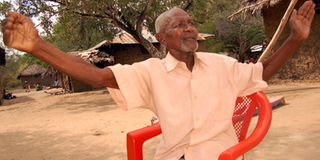Breaking News: At least 10 feared to have drowned in Makueni river
Lullaby that became National Anthem

Photo/LABAN WALLOGA/NATION
Mzee Galana Menza at his Wenje village home in Galole, Tana River. His tune was used to compose the National Anthem.
B-e-e mdondo b-e-,e
B-e-e mdondo b-e-,e
Akudhobee niganie,
Huende hukawabige,
Wantu wa makondeni,
Mwezi u-ya-wa chw-e-e-e
This Pokomo song might not strike Kenyans as being of any significance, nationalistic or otherwise.
For it is just a lullaby with words whose meaning is far removed from anything to do with national pride or politics… until, that is, someone sings it out aloud.
Then it would dawn on listeners that what they are hearing is the tune of Kenya’s National Anthem.
Just how did a simple village lullaby end up lending its tune to a song whose stanzas highlight the country’s sovereignty and its people’s resolve to protect and defend it?
The man credited with crafting the Anthem has the answer… although his role has been largely forgotten and ignored.
Mzee Galana Morowa Menza lives in Wenje, Galole in Tana River County.
Seated in the shade of a tree outside his makuti-thatched mud hut, he is graceful in old age, enjoying the company of his grandchildren.
Despite his age – his national identity card gives 1919 as his year of birth, making him a sprightly 92 – Mzee Galana demonstrates an inbred courtesy, rising to his feet and offering visitors his own seat.
As a young boy, he says, juggling school and cattle rearing, he found education to be fun, made more interesting by his German missionary teacher Herman Muller assisted by Mr Amos Chadhoro.
While at school he became interested in music that later it became a pastime that would take him many places.
He left school in class six at the onset of World War Two and together with other young men, were rounded up to work as guides for the British forces engaging the Italians in East Africa.
When the war ended, his father and some other local elders insisted that their sons must return to help to educate their young brothers and sisters in local schools, so Mzee Menza taught at Masalani primary school for six years before he was sent for a one-year course at Shimo la Tewa Teachers College.
He slowly built a reputation as a music teacher eventually meeting a Mr Graham Hislop, a music expert visiting East African schools.
“He called all music teachers in our area, placed us in different groups and asked us to come up with songs on different themes.
“I was in the group that settled on lullaby songs and I decided to sing the song B-e-e Mndondo B-e-e which I had learnt and mastered as a young boy,” Mzee Menza said.
Lodged with National Museum
According to him, the song’s simplicity and originality so impressed Mr Hyslop that he recorded it and took the recording back to Nairobi where it was lodged with the National Museum as part of the country’s cultural heritage.
Asked to translate the lullaby, Mzee Galana said: “It is simply an adult telling a child not to fear as the sound it is hearing is of a goat bleating. The adult asks who had wronged the child and then assures the young one that he would go to fight them - the people in the farms - while the moon is shining brightly….”
Mzee Menza says he forgot about the matter but unknown to him, a major surprise was in the offing as the country’s Independence loomed large in 1964.
The surprise came at midnight on Independence Day as he and a group of friends and relatives huddled around a radio to listen to speeches by the out-going colonial governor and then incoming leader Jomo Kenyatta.
“We silently listened to the King’s Anthem and after it ended, we prepared to hear our own new National Anthem which we had been told would be sang for the first time that night.
“Then the new National Anthem came on air. The tune was that of my song even though the words had been changed,” Mzee Galana recounted.
Asked how he felt that a tune he had given in his song had won such national distinction, Mzee Galana pauses and then says: “I was proud because I love my country.”
In spite of his role giving Kenya its National Anthem, Mzee Galana has little to show in terms of recognition and appreciation. The only time he came close to being feted as a national hero was during the tenure of Mr Nicholas Biwott as Tourism minister.
Then he was taken to Nairobi and introduced to dignitaries as the man who crafted the tune of the National Anthem.
A picture of the then Miss Tourism Kenya, Debra Sanaipei, awarding him a plaque of honour during the function in 2001 adorns his mud wall.
Lately, though, area district commissioner Mr Eric Obino has been inviting him to attend public celebrations in Hola Town where he is introduced to an appreciative crowd.




